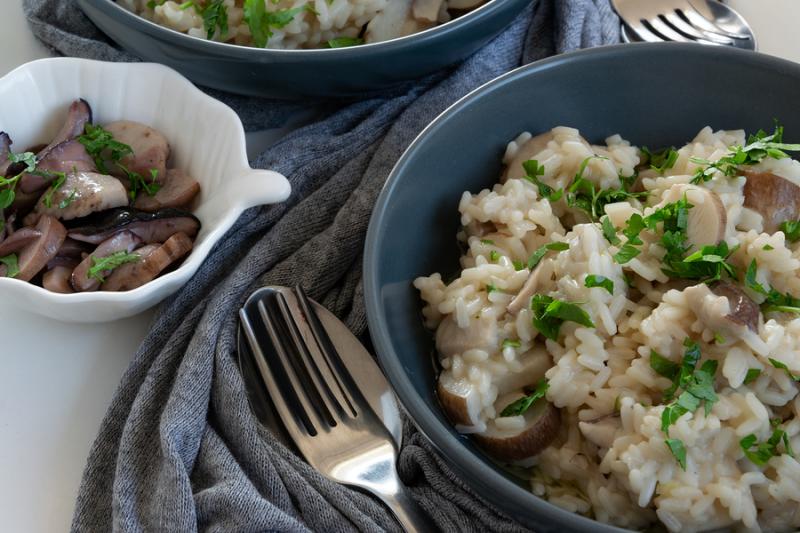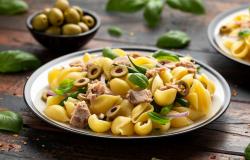The Quintessential Autumn Risotto
ITA:

Use player to listen to Italian version
A quintessential autumn dish, risotto with porcini mushrooms is typical of northern Italy, as most risotto dishes are; however, did you know rice first came to Italy via the south? It was brought by the Spaniards around the 15th century, and became popular in Naples, but was soon replaced by pasta, which the southerners seemed to prefer.
So rice ‘migrated’ to the north of Italy, where it found the ideal conditions to grow, favored especially by the abundance of water, particularly in Veneto and Lombardy.
Thus rice became a popular northern Italian dish, and its risotto variant even more so, combined with the most varied ingredients, from meats to seafood to vegetables.
Risotto is cooked with broth until it reaches a creamy consistency. The broth can be derived from meat, fish, or vegetables. Many types of risotto contain butter, onion, white wine, and Parmigiano cheese.
Here’s how to prepare risotto with porcini mushrooms.
Soak the dried mushrooms in warm water for about half an hour. Drain the mushrooms (keep the water) and cook them in a saucepan with two tablespoons of olive oil, a crushed clove of garlic; after a couple of minutes, add their filtered water. (If mushrooms are fresh, skip the soaking part.)
Meanwhile, prepare the vegetable stock by boiling about a liter of water with an onion, a stick of celery and a carrot.
To make a good risotto, it’s important to toast the rice before adding the broth: for this, heat two to three tablespoons of olive oil in a saucepan with chopped onions, pour the rice and let it pan-fry for two minutes, then add white wine. (Use Carnaroli rice.)
Once the wine has evaporated, add the vegetable broth: make sure to add the broth a little at a time, adding each ladle as the broth is absorbed by the rice.
After about ten minutes, add the mushrooms, stir and continue to add the broth until the rice is cooked al dente. Turn down the heat, and season with a little butter and grated Parmigiano until creamy, and chopped parsley at the end.
Piatto autunnale per antonomasia, il risotto ai funghi porcini è tipico del nord Italia, come la maggior parte dei risotti; tuttavia, lo sapevi che il riso è arrivato per la prima volta in Italia attraverso il sud? Fu infatti portato dagli spagnoli intorno al XV° secolo e si diffuse a Napoli, ma fu presto sostituito dalla pasta, che i meridionali sembravano preferire.
Così il riso ‘emigrò’ nel nord Italia, dove trovò le condizioni ideali per crescere, favorito soprattutto dall'abbondanza di acqua, in particolare in Veneto e Lombardia.
Per questo il riso divenne un piatto tipico del nord Italia e nella sua variante di risotto ancora di più, combinato con gli ingredienti più vari, dalla carne al pesce alle verdure.
Il risotto si cuoce nel brodo fino a raggiungere una consistenza cremosa. Il brodo può essere di carne, pesce o verdure. La maggior parte dei risotti si preparano con burro, cipolla, vino bianco e parmigiano.
Ecco come preparare il risotto ai funghi porcini.
Immergere i funghi secchi in acqua calda per circa mezz'ora. Scolare i funghi e cuocerli in una casseruola con due cucchiai di olio d'oliva e uno spicchio d'aglio schiacciato; dopo un paio di minuti, aggiungere la loro acqua filtrata. (Se i funghi sono freschi saltare l’ammollo.)
Nel frattempo, preparare il brodo vegetale facendo bollire circa un litro d'acqua con una cipolla, un gambo di sedano e una carota.
Per fare un buon risotto, è importante tostare il riso prima di aggiungere il brodo: per questo, scaldare 2-3 cucchiai di olio d'oliva in una casseruola con cipolla tritata, versare il riso e lasciarlo soffriggere per due minuti circa, quindi sfumare con vino bianco.
Una volta che il vino è evaporato, aggiungere il brodo vegetale: assicurarsi di aggiungere il brodo un po' alla volta, aggiungendo un mestolo man mano che il brodo viene assorbito dal riso.
Dopo una decina di minuti, aggiungere i funghi, mescolare e continuare ad aggiungere il brodo fino a quando il riso è cotto al dente. A fuoco spento, mantecare con un po' di burro e parmigiano grattugiato e aggiungere il prezzemolo tritato solo alla fine.











